Home
Hungary
Cardinal József Mindszenty
1956 Hungarian Revolution (My Story)
(My Eyewitness story of our Freedomfight
and Resistance against the Soviet Invasion)
50th Anniversary of our Freedomfight
My Travel and Photos Pages
Africa
America - North
America - Central
America - South
Asia
Australia
Oceania
My China pages directory
Beijing or Peking
Beijing Buses
Beijing - Forbidden City
Beijing - Prince Gong Palace
Beijing - Summer Palace
Great Wall of China
Guangzhou or Canton
Guangzhou Buses
Guangzhou trains
Hong Kong
Hong Kong Airport
Hong Kong Buses
Hong Kong - Lantau Island
Kashgar or Kashi
Kashgar Buses
Kashgar Sunday Market
Macau
Ming Dynasty Tombs
Peking Man's Caves/Zhoukoudian
Shanghai
Shanghai Buses
Shanghai Maglev / Transrapid
Shanghai Metro
Shenzhen
Shenzhen Buses
Tibet
Tibet - Lhasa
Tibet - Lhasa Monasteries
Tibet - Lhasa - Potala
Turpan or Tulufan
Turpan - Amin Mosque
Turpan - Astana Graves
Turpan - Bezeklik Caves
Turpan - Crescent Moon Lake
Turpan - Dunhuang Caves
Turpan - Echoing-Sand Mountain
Turpan - Ediqut Ruins
Turpan - Emin Minaret
Turpan - Flaming Mountains
Turpan - Gaochang Ruins
Turpan - Grape Valley
Turpan - Green Mosque
Turpan - Jesus Sutras
Turpan - Jiaohe Ruins
Turpan - Karez System
Turpan - Maza Village
Turpan - Mogao Caves
Urumchi or Urumuchi
Xian
Xian Buses
Xian - Hua Qing Pool
Xian - Silk Factory
Xian - Silk Road Monuments
Xian - Terracotta Factory
Xian - Terracotta Army Museum
Yanan
Yanan Buses
Yanan Cave Dwellings
|

China facts & history in brief
 My China pages directory
My China pages directory
Map of China
Tibet / Lhasa Monasteries
Lhasa is mind blowing.
It is beautiful, unusual and incredible.
I was looking forward to visit the Potala, I was mesmerised with
it the first time I have seen it and read about it.
The more I have read, the more fascinated I became with it.
I was anxiously waiting for the time to go
up and visit the Potala.
I was also terrified the day before, because I
smoked at the time, my age,
the altitude and the height of the Potala, but mainly
because of the warnings.
You will never guess, the next morning the bus taken
us nearly to the top of it, from behind.
We could not see the road up to it, behind the
buildings and I never seen the rear entrance
ever mentioned before.
I was expecting to climb up all those steps
visible on the front.
Amazing place, amazing sights.
We really enjoyed ourselves.
Superb!!
An unforgettable experience.
We've have had a terrific time!!

The Potala Palace was the chief residence of the
Dalai Lama until the 14th Dalai Lama fled to Dharamsala,
India after a failed uprising in 1959.
Today the Potala Palace has been forcibly converted into
a museum by the Chinese.
It was named after Mount Potala, the abode of
Chenresig or Avalokitesvara.
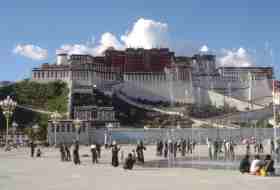
Thirteen stories of buildings containing over 1,000 rooms,
10,000 shrines and about 200,000 statues, soar 117 metres
(384 ft) on top of Marpo Ri, the "Red Hill", rising more
than 300 m (about 1,000 ft) in total above the valley floor.
It measures 400 metres east-west and 350 metres north-south,
with sloping stone walls averaging 3 m. thick, and 5 m.
(more than 16 ft) thick at the base, and with copper poured
into the foundations to help proof it against earthquakes.
"The Potala gives the impression not of having been built
by man but have grown there, so perfectly does
it fit in with its surroundings.
It has the pleasing lack of symmetry of a great tree or
mountain, yet this apparent aimlessness is focused, first
by the red central block and then by the golden pavilions
on the roof, so that the eye is naturally led from the
less important to the essential, both visually and
spiritually; for in so much as the gilded roofs over the
mortal remains of the Dalai Lamas are the dominant
figure of the architecture, so is the incarnate spirit
of these rulers the very soul of Tibet."
Potala Palace Wikipedia, the free encyclopedia
____________o______O______o____________
More or less in the centre of Lhasa is the
Jokhang, also called the Jokang, Jokhang Temple,
Jokhang Monastery or Tsuklakang, is a famous Buddhist
temple located on Barkhor Square in Lhasa.
When it was originally built during the reign of king
Songsten Gampo (605?-650), it was called the Tsulag Khang
or 'House of Wisdom' but it is now known as the Jokhang
which means the 'House of the Lord'.
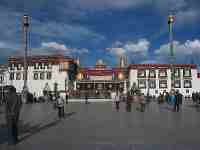
For most Tibetans it is the most sacred
and important temple in Tibet.
Along with the Potala Palace, it is probably the
most popular tourist attraction in Lhasa.
It is part of the UNESCO World Heritage Site
"Historic Ensemble of the Potala Palace" and
a spiritual centre of Lhasa.
During our visit to Lhasa we stayed at a Hotel
on Barkhor Street over looking Barkjor Square
and seen the constant moving of worshipers going
around the Jokhang in a clockwise direction,
sometimes we joined in too for the experience,
although being practising Catholics.
Jokhang Wikipedia, the free encyclopedia
____________o______O______o____________
The Barkhor is an area of narrow streets and a public
square located around Jokhang Temple.
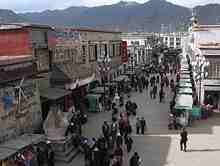
The Barkor was the most popular devotional circumabulation
for pilgrims and locals.
The walk was about one kilometre long and encircled the entire
Jokhang, the former seat of the State Oracle in Lhasa called
the Muru Nyingba Monastery, and a number of nobles' houses.
Most of the old streets and buildings have been demolished in
recent and replaced with wider streets and new buildings.
Barkor Wikipedia, the free encyclopedia
____________o______O______o____________
Norbulingka is a palace and surrounding park in Lhasa,
Tibet which served as the traditional summer residence
of the successive Dalai Lamas from the 1780s up until
the PRC takeover in the late 1950s.
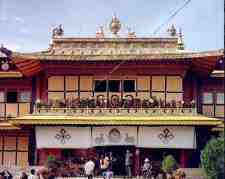
The park was built by the Seventh Dalai Lama beginning
in 1755, and became the summer residence during the
reign of the Eighth Dalai Lama.
Norbulingka Wikipedia, the free encyclopedia

Lhasa is the capital and
holy city of Tibet.
Tibetans consider
the city's temples sacred.
The Dalai Lama, a spiritual leader and exiled
ruler of Tibet, lived in Lhasa until 1959.
After the failed revolt in Tibet
against the Chinese Communists,
he went into exile in India with many of
his followers.
Until 1904, Europeans were banned from
Lhasa, and it is sometimes
called The Forbidden City.
The 13-floor Potala Palace
stands out above the city.
Now a museum, the palace once
served as a temple, the centre of Tibet's
government, and the home
of the Dalai Lama.

I've heard and read a number of stories about a lost
city of El Dorado or a dream city or
Paradise, and many of these
stories put it somewhere in the Himalayas.
Or is it Tibet?
Or is it Lhasa?
I'll let you draw your own conclusions.

Tibet 1999
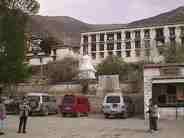 |
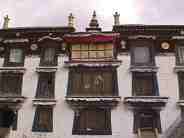 |
| Monastery |
Monastery |
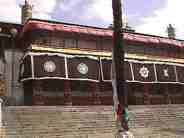 |
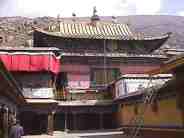 |
| Monastery |
Monastery |

|